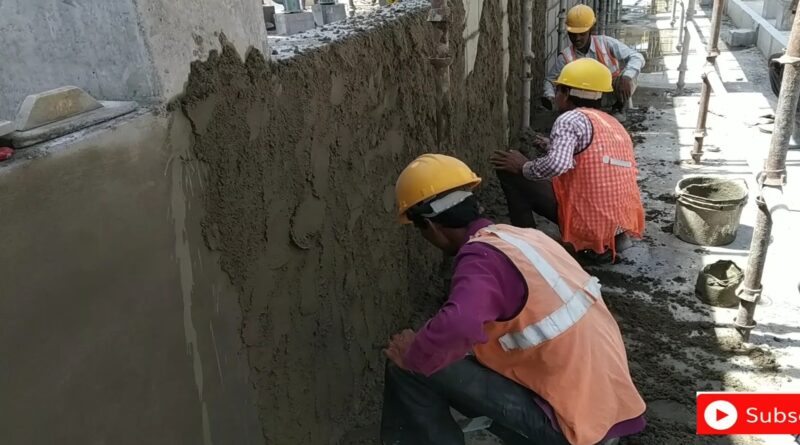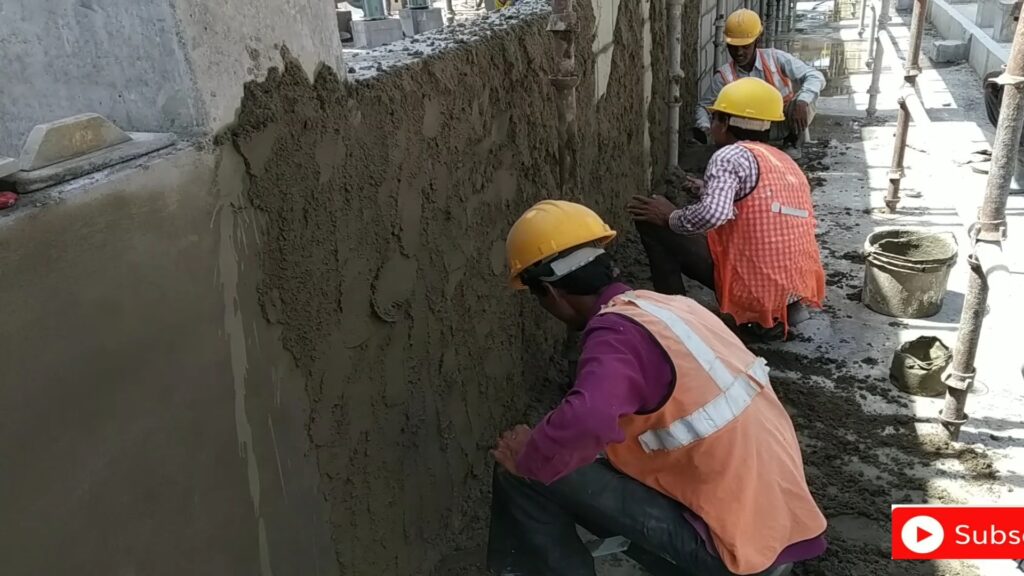Work Procedure of wall plaster with Quality
Surface Preparation
The joints of wall shall be raked out properly for minimum 10mm and dust and loose mortar shall be brushed out. Concrete surfaces shall be roughened using light hammering when concrete is still green.
Efflorescence, if any shall be removed by brushing out and scraping. The surface shall then be thoroughly washed with water, cleaned and kept wet before plastering is commenced. Over watering shall be avoided as it will reduce the suction action of the wall on plaster.
Preparation of Mortar:
The material for mortar for plaster and its preparation shall be as detailed here in.
- The mortar shall be consumed before it starts hardening and in no case it shall be kept unused for more than 30 minutes.
- Unless otherwise mentioned, the proportion for mortar for undercoat shall be 1:5 (cement: sand) by volume and that for finishing coat shall be 1:3 (Cement: sand) by volume.
- For external plasters, Recron 3S fibers of 6 mm length shall be used in mortar.Dosage shall be 0.25% by weight of cement. This reduces rebound loss, shrinkage cracks & water ingress while increasing compressive strength.
Application of Plaster
Plaster shall generally be applied in two coats namely, an undercoat and a
finishing coat. Undercoat shall be about 10mm to 15mm in thickness depending upon the unevenness of the surface. Finishing coat generally varies from 3mm to 8mm depending upon the finish required. Unless noted otherwise the external sand faced plaster shall consist of 12mm undercoat and 6mm finishing coat.
Plastering shall be started from top and worked down towards floor. All holes shall be properly filled in advance of plastering. Plaster shall be applied with force either manually or by mechanical means.All corners, angles, arises and junctions shall be made truly vertical and horizontal as the case may be and shall be carefully finished. Rounding or chamfering corners, arises, angles etc. where required shall be done as the work proceeds.Such rounding or chamfering shall be carried out with proper templates to the size required.
When work is suspended at the end of the day, the plaster shall be left, cut clean to line both horizontally and vertically. When plastering is resumed, the edge of the old work shall be scraped, cleaned and wetted with water before plaster is applied to the adjacent areas. Plastering work shall be closed at the end of the day on the body of the wall and not nearer than 150 mm to any corners or arises.It shall not be closed on the body of features like bands, cornices etc. and not at the corners.
Undercoat:
Plaster patches of required thickness and size 150 x 150 mm shall be made over the surface to be plastered at an interval of about 2m x 2m horizontally and vertically to cover the entire surface to serve as gauges. The surface of these gauges shall be truly in the plane of the finished plaster surface. The plaster shall be applied in a uniform surface slightly more than the final undercoat thickness required and then brought to a true surface, by working with a wooden straight edge reaching across the gauges, with small upwards and sideways movements at a time. The surface shall be left rough and furrowed 2 mm deep with scratching tool diagonally both ways, to form keys for the finishing coat. The surface shall be kept wet till finishing coat is applied.
Curing:
Curing shall be started after the plaster gains sufficient strength not to be
damaged and washed off by water. The surface of plaster shall be kept wet for at least 7 days and shall be protected from the sun and heavy rains. The dates on which plastering is done shall be legibly marked on the various sections plastered to help monitor the curing period
Acceptance Criteria
The thickness of the plaster specified shall be measured exclusive of the thickness of the key i.e. grooves, or open joints in the masonry. The average thickness of plaster shall not be less than the specified thickness. The minimum thickness over any portion of the surface shall not be less than specified thickness by more than 3 mm.



Please make another WhatsApp Group because your group is full and telegram link is inappropriate
message me on it 706672812